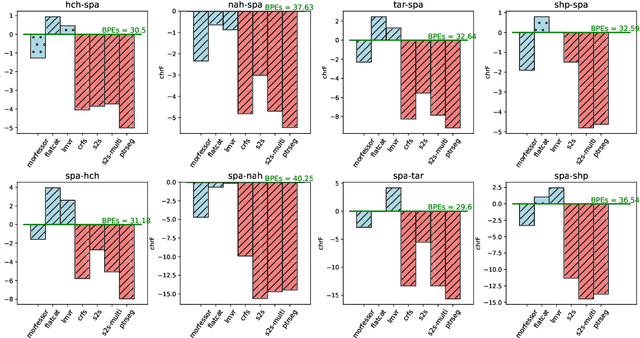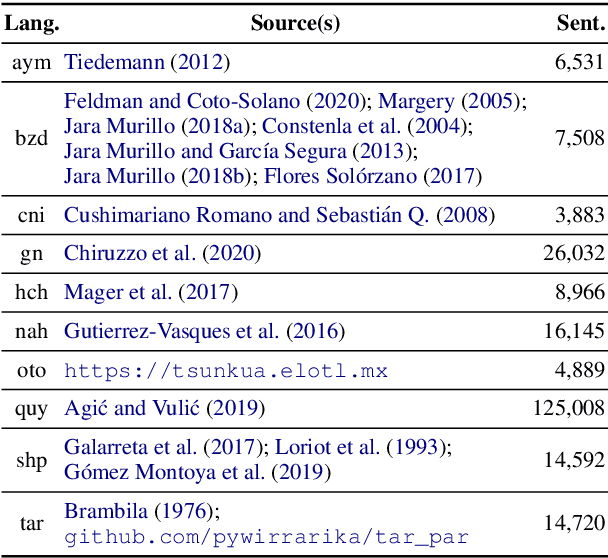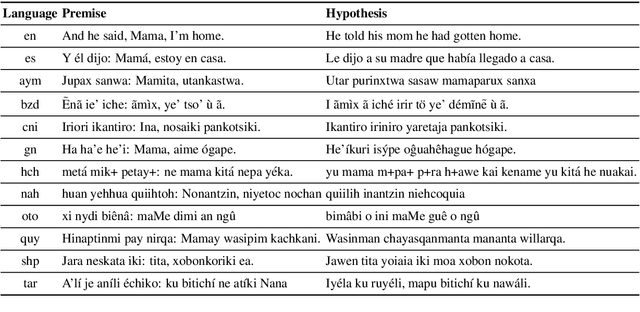Elisabeth Mager
Ethical Considerations for Machine Translation of Indigenous Languages: Giving a Voice to the Speakers
May 31, 2023Abstract:In recent years machine translation has become very successful for high-resource language pairs. This has also sparked new interest in research on the automatic translation of low-resource languages, including Indigenous languages. However, the latter are deeply related to the ethnic and cultural groups that speak (or used to speak) them. The data collection, modeling and deploying machine translation systems thus result in new ethical questions that must be addressed. Motivated by this, we first survey the existing literature on ethical considerations for the documentation, translation, and general natural language processing for Indigenous languages. Afterward, we conduct and analyze an interview study to shed light on the positions of community leaders, teachers, and language activists regarding ethical concerns for the automatic translation of their languages. Our results show that the inclusion, at different degrees, of native speakers and community members is vital to performing better and more ethical research on Indigenous languages.
BPE vs. Morphological Segmentation: A Case Study on Machine Translation of Four Polysynthetic Languages
Mar 16, 2022



Abstract:Morphologically-rich polysynthetic languages present a challenge for NLP systems due to data sparsity, and a common strategy to handle this issue is to apply subword segmentation. We investigate a wide variety of supervised and unsupervised morphological segmentation methods for four polysynthetic languages: Nahuatl, Raramuri, Shipibo-Konibo, and Wixarika. Then, we compare the morphologically inspired segmentation methods against Byte-Pair Encodings (BPEs) as inputs for machine translation (MT) when translating to and from Spanish. We show that for all language pairs except for Nahuatl, an unsupervised morphological segmentation algorithm outperforms BPEs consistently and that, although supervised methods achieve better segmentation scores, they under-perform in MT challenges. Finally, we contribute two new morphological segmentation datasets for Raramuri and Shipibo-Konibo, and a parallel corpus for Raramuri--Spanish.
AmericasNLI: Evaluating Zero-shot Natural Language Understanding of Pretrained Multilingual Models in Truly Low-resource Languages
Apr 18, 2021



Abstract:Pretrained multilingual models are able to perform cross-lingual transfer in a zero-shot setting, even for languages unseen during pretraining. However, prior work evaluating performance on unseen languages has largely been limited to low-level, syntactic tasks, and it remains unclear if zero-shot learning of high-level, semantic tasks is possible for unseen languages. To explore this question, we present AmericasNLI, an extension of XNLI (Conneau et al., 2018) to 10 indigenous languages of the Americas. We conduct experiments with XLM-R, testing multiple zero-shot and translation-based approaches. Additionally, we explore model adaptation via continued pretraining and provide an analysis of the dataset by considering hypothesis-only models. We find that XLM-R's zero-shot performance is poor for all 10 languages, with an average performance of 38.62%. Continued pretraining offers improvements, with an average accuracy of 44.05%. Surprisingly, training on poorly translated data by far outperforms all other methods with an accuracy of 48.72%.
Lost in Translation: Analysis of Information Loss During Machine Translation Between Polysynthetic and Fusional Languages
Jul 01, 2018

Abstract:Machine translation from polysynthetic to fusional languages is a challenging task, which gets further complicated by the limited amount of parallel text available. Thus, translation performance is far from the state of the art for high-resource and more intensively studied language pairs. To shed light on the phenomena which hamper automatic translation to and from polysynthetic languages, we study translations from three low-resource, polysynthetic languages (Nahuatl, Wixarika and Yorem Nokki) into Spanish and vice versa. Doing so, we find that in a morpheme-to-morpheme alignment an important amount of information contained in polysynthetic morphemes has no Spanish counterpart, and its translation is often omitted. We further conduct a qualitative analysis and, thus, identify morpheme types that are commonly hard to align or ignored in the translation process.
 Add to Chrome
Add to Chrome Add to Firefox
Add to Firefox Add to Edge
Add to Edge